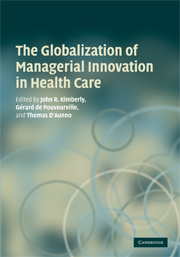Book contents
- Frontmatter
- Contents
- List of figures
- List of tables
- List of contributors
- Acknowledgements
- Introduction
- 1 Origins of DRGs in the United States: A technical, political and cultural story
- 2 Casemix in the United Kingdom: From development to plans
- 3 Casemix implementation in Portugal
- 4 From naïve hope to realistic conviction: DRGs in Sweden
- 5 Casemix in Denmark
- 6 DRGs in France
- 7 Introduction and use of DRGs in Belgium
- 8 DRGs in Germany: Introduction of a comprehensive, prospective DRG payment system by 2009
- 9 Casemix in Switzerland
- 10 The first decade of casemix in Italy
- 11 Casemix development and implementation in Australia
- 12 Diagnosis procedure combination: The Japanese approach to casemix
- 13 Casemix in Singapore
- 14 Experiences with the application of the DRG principle in Hungary
- 15 Casemix systems – past, present, and future: The Canadian experience
- 16 Conclusions: The global diffusion of casemix
- Index
- References
3 - Casemix implementation in Portugal
Published online by Cambridge University Press: 24 February 2010
- Frontmatter
- Contents
- List of figures
- List of tables
- List of contributors
- Acknowledgements
- Introduction
- 1 Origins of DRGs in the United States: A technical, political and cultural story
- 2 Casemix in the United Kingdom: From development to plans
- 3 Casemix implementation in Portugal
- 4 From naïve hope to realistic conviction: DRGs in Sweden
- 5 Casemix in Denmark
- 6 DRGs in France
- 7 Introduction and use of DRGs in Belgium
- 8 DRGs in Germany: Introduction of a comprehensive, prospective DRG payment system by 2009
- 9 Casemix in Switzerland
- 10 The first decade of casemix in Italy
- 11 Casemix development and implementation in Australia
- 12 Diagnosis procedure combination: The Japanese approach to casemix
- 13 Casemix in Singapore
- 14 Experiences with the application of the DRG principle in Hungary
- 15 Casemix systems – past, present, and future: The Canadian experience
- 16 Conclusions: The global diffusion of casemix
- Index
- References
Summary
Introduction
Since 1979, the Portuguese health care system has been based on a National Health Service (NHS) structure, with public insurance, universal coverage, almost free access at the point of use, and general taxation financing. The state is committed to providing health protection for the whole population and equity objectives are prominent. This has been reinforced by successive legislation, which also attributed to the Portuguese health care system the objectives of promoting efficiency, quality, and accountability (Assembleia da República 1990). Nonetheless, it should be highlighted that, in reality, the Portuguese NHS has never conformed to the general characteristics of the Beveridge model, mainly because of an incomplete transition from a previously fragmented social insurance system. Occupation-based insurance schemes that existed in 1979 are yet to be integrated into the NHS, meaning additional coverage for the one provided by the NHS for around 20–25 percent of the population (OECD 1998). These occupation-based insurance schemes, which benefit from additional public funding and allow families to enjoy double coverage, contribute to inequalities in access. A large private sector co-exists with the NHS and its role was explicitly recognized in the 1990 NHS law that instituted a mixed health care system involving both the public and private sectors (Assembleia da República 1990). The private sector is mainly responsible for visits to specialists, elective surgery, ancillary tests and kidney dialysis.
Figure 3.1 depicts key institutions and financial/service relationships between the stakeholders in the Portuguese health care sector (Oliveira and Pinto2005).
- Type
- Chapter
- Information
- Publisher: Cambridge University PressPrint publication year: 2008



